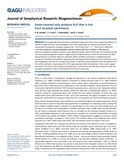Snow covered soils produce N₂O that is lost from forested catchments prior to snowmelt
Metadata
Afficher la notice complèteAuthor
Enanga, E.M.
Creed, I.F.
Fairweather, T.
Casson, N.J.
Date
2016-08-25Citation
Enanga, E.M., I.F. Creed, T. Fairweather, and N.J. Casson. “Snow covered soils produce N₂O that is lost from forested catchments prior to snowmelt.” Journal of Geophysical Research – Biogeosciences 121 (9) (September 2016): 2356–2368. DOI: 10.1002/2016JG003411.
Abstract
The magnitude of net soil nitrous oxide (N₂O) production from a snow‐covered catchment in a northern temperate forest was investigated. There was considerable net soil N₂O‐N production and consumption through the snowpack, ranging from −6.6 to 26.2 g‐N ha⁻¹ d⁻¹. There was no difference in net N₂O production among topographic positions despite significant variation in soil moisture, reduction‐oxidation conditions, and pore water dissolved organic carbon and nitrate. Soil temperatures did not vary among topographic positions, suggesting that temperatures at or above the freezing point allow N₂O production to proceed under the snowpack. Redox conditions were lower at wetland positions compared to lowlands and uplands, suggesting that the biogeochemical pathway of N₂O production varies with topography. Over the entire nongrowing season, 1.5 kg of N₂O‐N was exported to the atmosphere from the 6.33 ha catchment, representing 31% of the growing season N₂O‐N production. These results suggest that winter is an active time for gaseous N production in these forests and that N₂O production under the snowpack represents an often unmonitored flux of N from catchments.

